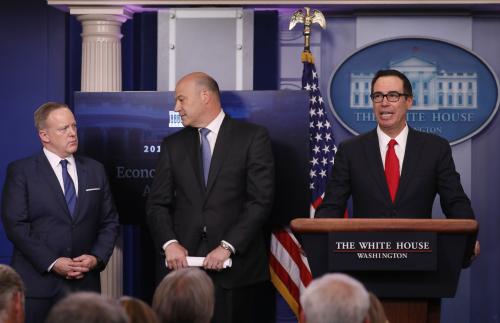Although the Senate Budget Committee has not yet finished marking up its version of the fiscal year 2010 budget resolution, the contour of congressional Democrats’ response to President Obama’s initial submission is already coming into view. Simply put: while they support most of the president’s priorities, they are poised to sideline many of the programs he proposed to implement those priorities. And the administration’s response to Congress is becoming clear as well: it will take whatever Congress produces and declare victory.
Still, the budget resolution that emerges from this process is likely to diverge from the president’s desires more than either Congress or the administration is willing to acknowledge. There are two principal reasons for this early display of congressional independence. First, some of the president’s proposals sparked disagreements among Democrats. Second, the Congressional Budget Office’s analysis of the president’s budget, projecting deficits of $9.3 trillion over the next decade, created sticker shock and forced congressional leaders to look for changes that could be represented as reducing the deficit.
Here are some of the early casualties:
- Neither the House nor the Senate is prepared to put cap-and-trade legislation on a budgetary fast track, impeding its passage for at least a year. Putting the best face on this set-back, the president’s OMB director, Peter Orszag, said that “the political economy of getting climate change done this year may actually be better . . . outside of the budget resolution than inside of it.”
- The president wanted to use the revenues from cap-and-trade to make his payroll tax relief plan for low and moderate income workers permanent. Without those revenues, it now appears highly unlikely that this will happen anytime soon. The OMB director has more or less conceded this, saying that the temporary payroll tax relief in the stimulus bill gives Congress and the administration “two years to figure this out.”
- The president proposed a $634 billion fund, divided evenly between spending cuts and revenue increases, as a reserve or down-payment on comprehensive health reform. While Congress will go along with the concept of a reserve, the Senate budget resolution specifies no revenue sources, and the final bill will set aside less much than the president wanted. One reason: the administration’s key revenue proposal—reducing the itemized deduction rate for families with incomes over $250,000—has proved wildly unpopular (especially among charities) and will almost certainly be scrapped.
- The president wanted to convert Pell grants for lower-income college students from an annual discretionary appropriation into a permanent mandatory program. For different reasons, both the House and the Senate are refusing to endorse this change.
- Finally, both houses have declined to include the president’s proposed $250 billion for future bailouts of the financial system. If the president wants additional funding for this purpose down the road, he will have to make a free-standing request and take his chances.
To be sure, none of these reverses prevents President Obama from pressing ahead on these priorities through the regular legislative process. The chair of the Senate Budget Committee, Kent Conrad, emphasized this point. “We have not prejudged a legislative outcome,” he said. “We have made it possible for the committees of jurisdiction to do what the president is asking for on climate change, to do what he is asking for on health care, on energy, and education, but all of them would have to be offset”—that is, financed in a way that would not add to the budget deficit.
So what do these developments portend for the president’s agenda?
Because of sharp partisan polarization, the contemporary House of Representatives functions as a quasi-parliamentary body in which the dominant party can use majoritarian procedures to get its way. The real action is in the Senate, where opportunities to restrict debate are far more limited and where minority of 41 senators can prevent final legislative action. The majority has two choices: either it reaches out to the opposition to forge a super-majority, or it tries to use a special budgetary procedure known as reconciliation to get its way with as few as 51 votes.
This is where differences between the House and Senate approaches to the FY 2010 budget may prove crucial. The House version of the budget resolution authorizes the use of reconciliation procedures to expedite consideration of several administration initiatives, including comprehensive health reform. But Senator Conrad strongly disagrees. “I don’t believe reconciliation was ever intended for this purpose,” he said. “It doesn’t work well for writing major substantive legislation.” On the other hand, Harry Reid, the Senate majority leader, reportedly favors keeping reconciliation open as an option. Max Baucus, the chair of the Senate Finance Committee, is reluctant to abandon a bipartisan approach, especially on health care.
Even if the final budget resolution includes language authorizing reconciliation, it remains an open question whether the bills produced under this rubric can be included in a so-called omnibus budget reconciliation act that can be passed with a simple majority. Since the mid-1980s, the “Byrd rule” (named for its author, Sen. Robert Byrd [D-WV]) has allowed any senator to challenge the relevance of any matter to the overall purpose of the reconciliation bill. Once such a challenge has been raised, it takes a three-fifths vote of the members (60 if the full body participates) to retain that matter in the bill. It is entirely possible, then, that measures crafted by the Democratic majority could be challenged during the reconciliation process and stripped from the bill—that is, unless some Republicans stepped forward to provide the additional votes needed to retain it.
Surviving a challenge is not easy. During the first two decades the Byrd rule was in effect, 55 challenges occurred, and 42 of them succeeded in removing the contested matter from the omnibus bill. Conventional wisdom is in fact correct: more often than not, large legislative changes require some measure of cooperation across party lines. (28 House Democrats and 10 Senate Democrats voted for final passage of the 2001 Bush tax cuts.) Before Democrats decide to bypass the compromises that bipartisan cooperation requires, they should at least consider the lessons of recent history.



Commentary
Op-edWill Obama’s Agenda Pass Congress’s Budget Resolution?
March 26, 2009